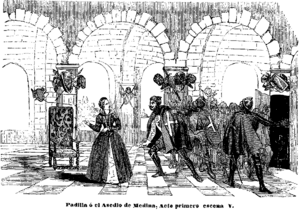Joaquín Espín y Guillén facts for kids
Quick facts for kids
Joaquín Espín y Guillén
|
|
|---|---|
| Born | 3 May 1812 |
| Died | 24 June 1882 (aged 70) |
| Known for | pioneer of zarzuela |
| Spouse(s) | Josefa Pérez Colbrand |
Joaquín Espín y Guillén (born May 3, 1812, died June 24, 1882) was a Spanish composer and musician. He is famous for being a pioneer of zarzuela, a special type of Spanish musical theater. He helped create and popularize this unique art form.
Contents
Early Life and Education
Joaquín Espín y Guillén was born on May 3, 1812. His birthplace was Velilla de Medinaceli, a town in Soria, Spain. His parents were Joaquín Espin y Beltrán and Josefa Guillén e Igual.
He spent his early years with his grandparents in Cuzcurrita, La Rioja. Later, he lived with his parents. Joaquín started learning music theory and how to play the organ. His first teacher was José Aramburu, an organist at the Cathedral of Santo Domingo de la Calzada.
Later, he moved to Burgos to continue his music training. There, he studied with other organists named Vicente Pueyo and Ciriaco Olave. In 1831, Joaquín traveled to Bordeaux, France. For nine months, he learned from a pianist named Hoffmann.
After returning from France, Espín passed an exam to become an organist in Santo Domingo de la Calzada. In 1833, he moved to Madrid. He joined the Royal Conservatory of Music and Declamation to continue his studies. While studying in Madrid, Espín also started teaching singing and piano lessons.
On January 29, 1836, he married Josefa Pérez Colbrand. She was a niece of Rossini's first wife, a singer named Isabella Colbran. Joaquín and Josefa had four children. Their son, Joaquín, became a well-known conductor. Their daughter, Julia, became a famous opera singer. She was also a muse for the writer Gustavo Adolfo Bécquer. They also had two other daughters, Josefina and Ernestina.
Musical Journey
Joaquín Espín y Guillén held important positions in the music world. From 1838 to 1842, he was the President of the Music Section of the Artistic Lyceum. He also taught at the Matritense Museum from 1841 to 1845. For two years, he was the Vice President of the Music Section at the Spanish Institute.
Founding a Musical Newspaper
On January 2, 1842, Espín started the first Spanish musical newspaper. It was called La Iberia Musical. For five years, until 1846, Espín was its director and owner. He also wrote many of the articles for the newspaper.
In late 1845, Espín went to Bologna, Italy. Gioachino Rossini asked him to help with the will of Rossini's first wife, Isabel Colbrand. While in Bologna, Espín had the chance to meet another famous composer, Giuseppe Verdi. In October 1847, Espín created an organization called Círculo Filarmónico. This group offered a different way to learn music compared to the Madrid Conservatory.
Work in Theaters and Academies
In 1851, he worked as a choirmaster and director of the military band at the Royal Theater. Espín was also the president of the Matritense Philharmonic Academy.
From 1851 to 1855, Espín wrote articles about music. He worked with Ramón Mesonero Romanos and Pedro Madrano. These articles were for the Modern Encyclopedia, started by Francisco de Paula Mellado.
In 1853, Espín asked Queen Isabella II to create a music section. He wanted this section to be in the National Library. However, his request was not approved.
Composing Zarzuelas
Espín wrote his first zarzuela, called Carlos Broschi. It was first performed in Seville on February 12, 1854. This zarzuela was staged until 1856. His second zarzuela, El encogido y el estirado, premiered on March 14, 1857.
During the 1850s, Espín composed four zarzuelas. He believed this new type of musical theater could become Spain's national opera. From May 1862, Espín worked as an organist in the Royal Chapel. From 1865 to 1867, he was a choirmaster at the Royal Theater. After the Madrid Conservatory was changed, he was appointed a professor on June 20, 1868.
From January 1869, Espín wrote music reviews for La Iberia. He also worked with Diario Politico until August 1872. For almost four years, from August 1878 to February 1881, he wrote music criticism for La Politica. In February 1882, Espín returned to teach solfeggio at the Madrid Conservatory.
Joaquín Espín y Guillén passed away on June 24, 1882, in Madrid.
See also
 In Spanish: Joaquín Espín y Guillén para niños
In Spanish: Joaquín Espín y Guillén para niños


